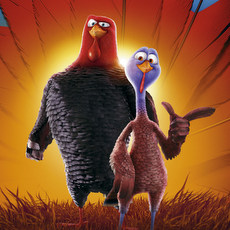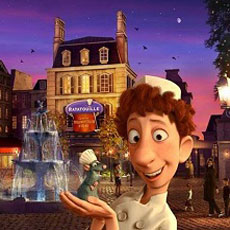 There are films which are made by true creators who have unique points of view. Pachamama is one of them.
There are films which are made by true creators who have unique points of view. Pachamama is one of them.
Directed by Mercano The Martian‘s Juan Antin and produced by Academy Award nominee Didier Brunner ( The Old Lady And The Pigeons, Kirikou And The Sorceress, The Triplets Of Belleville, The Secret Of Kells and Ernest And Celestine), the visual and musically stunning animated feature follows Tepulpaï, a mischievous 10-year-old who dreams of becoming a shaman. As the villagers are gathering to make an offering to their great spirit Pachamama, the ceremony is disrupted by an Incan overlord who confiscates the town’s golden statue. Tepulpaï sees the chance to show his mettle and sets off to recapture the irreplaceable treasure, joined (whether he likes it or not) by his friend Naira and her smart-talking pet llama. Together, they make a journey across uncharted lands, full of unknown obstacles and dangers.
Netflix has a robust slate of animated event programming that reflects diverse perspectives and cultures in a variety of styles and formats, designed for families around the world. A few months ago, they acquired the rights to Pachamama and are planning to debut this beautiful film in select territories worldwide on June 7th.
We turned to Director Juan Antin to tell us more about this animated gem.
AnimatedViews: How did you get the spark that led you to create Pachamama?
Juan Antin: The first idea came to me in the form of a vision, when I was participating in the Latino-American Film Festival in Cuba for my first film, Mercano the Martian, back in 2004. One afternoon, I was sitting on a beach in La Havana, and while I was staring at the sea and the horizon, I imagined how, on the very same beaches but more than five hundred years before, the natives were watching the first European conquistadors arrive, and how disappointed they must have been when they realized that those strange creatures, looking like gods in their shining armor, were only bringing along the most savage part of their humanity. I left the beach that day with the seed of what was to become Pachamama.
Then it took me a few years of research and travels, first to the north of Argentina where my wife, María Hellemeyer, who’s an anthropologist, was doing social work and research on native communities. There, I had the chance to meet the shamans and chiefs of the communities and started interviewing them. I wanted to have their point of view for this film. Those research trips took us to Bolivia and Peru, always in contact with indigenous communities. and we learned more about the culture of Pachamama, which is still very vivid in the Andean region.
So, I started writing the story while María, who is also a visual artist, started to do some sketches that would be the basis of the visual universe of the film. But, at that time, I was imagining it as a stop-motion film. I even shot a teaser, but then I was delayed by difficulties on the funding of the project. In Argentina, after the economic crisis it got difficult to make such an ambitious project. I’ve moved to France to coproduce it there and, with some ups and downs, I was finally able to start production in 2015 at Folivari, Didier Brunner’s studio. Finishing in 2018, it took me 14 years to go from the idea to the screen!
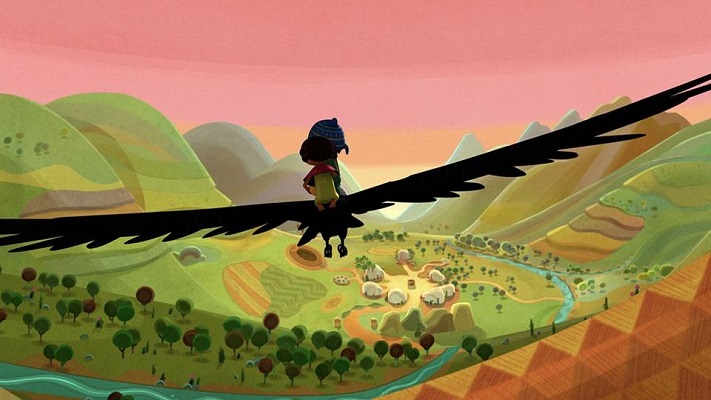
AV: How did you envision your story?
JA: The story is basically an initiation journey. Tepulpaï, the main character is a boy who wants to be a shaman but he’s egoist, reckless and full of pride and has a lot to learn… Because in the shamanic cosmovision, man sees himself as a part of a whole, a spiritual perspective which implies that he feels love, respect and gratitude to the Earth and all that is living. Unlike the European conception at that time, whereby man saw himself as the center of creation, ordered, by biblical injunction, to dominate all and become master of the Earth. These two antagonistic conceptions are intrinsic in the story and play a huge part in how each character sees the world.
Tepulpaï‘s journey to become a shaman is a bit like ours, nowadays, in our becoming aware and our understanding of the Earth’s fragile balance and the ravages left by centuries of disharmony and wars between men.
AV: Nature seems an essential aspect of your story.
JA: The film is, above all, an ode to nature. In Quechua, the language of the Incas, Pachamama means Universal Mother. More than that, the indigenous cultures consider human beings, along with all animals and plants, to be part of the Earth itself, all together like a huge living organism. I think that this is a beautiful way to see nature, so the whole concept of the film, not just narrative but also graphical, is based on that idea.
AV: How did you work your story out regarding History and Mythology?
JA: This story is completely fictional; even though the inspiration came from the true History of the Conquest, it’s freely adapted and there are no true historical characters. Sure, there are a lot of elements of the Andean Cosmogony like Inti, the Incan Sun God, or Mamaquilla, the moon, or even Pachamama, but all this gave me just a context where characters would build their own story. I think that all that research helped us to be truly authentic to the Andean Cosmogony, and this gave the film a high cultural value and even a pedagogic interest.
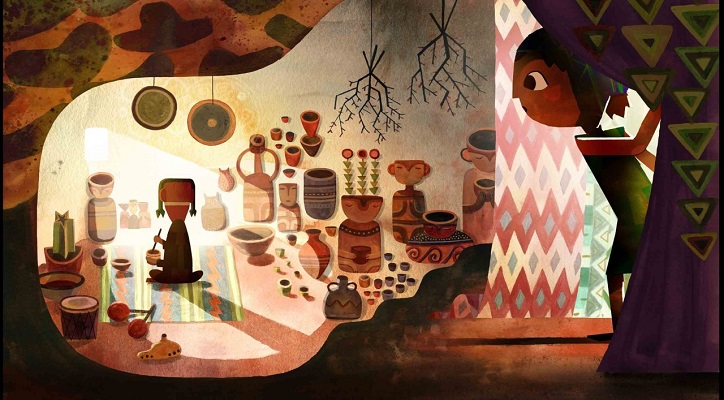
AV: How did you create the visual style of the movie, its design and magnificent color palette?
JA: To create the graphic world of Pachamama, the idea was to base all the graphics on pre-Columbian Andean art, trying to immerse the audience in a different and truly authentic world built upon very simple elements like patterns, Andean designs, and vibrant colors. For the character, the inspiration came mostly from pottery. We used to look at those vases and see very funny characters; they are simple yet powerful and very expressive. And for the backgrounds, we’ve based them on Andean patterns like those found on textiles and pottery. They are very geometrical and repetitive designs that have a powerful effect.
Colors in the Andes are vibrant; that’s maybe because of the effect of altitude with a thinner atmosphere and a very powerful sunlight. People there use a great variety of rich colors on their clothes, combinations of turquoise, fuchsia, yellow… even the mountains, loaded with minerals, have plenty of different colors. In a film, I think colors produce a very powerful effect on the emotion of the audience.
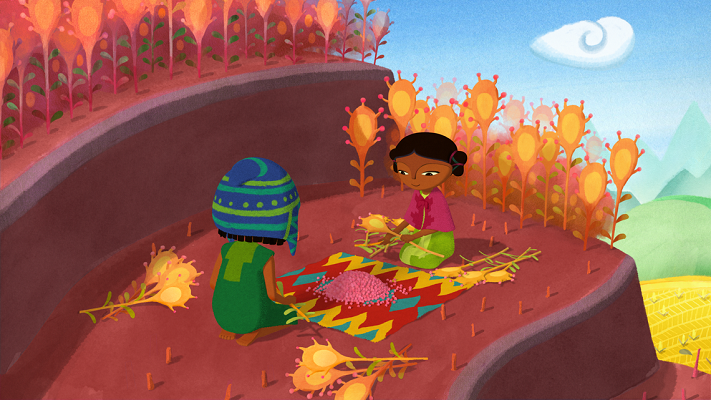
AV: What was Michel Ocelot’s influence on the movie?
JA: I met Michel Ocelot in the Annecy Film Festival when I was presenting my first film Mercano The Martian. My film was awarded there and Michel was there too. He loved the movie so much that he gave me a special prize that he personally created: “The Golden Kirikou for
AV: How did you organize the production of the animation?
JA: Because it was an international coproduction, we had to share the different tasks between the different studios. Thus, the production had a quite complex pipeline, with a team of more than 100 people, scattered in two continents and three countries (France, Luxembourg and Canada). All the 3D character animation was done in Montreal, the color backgrounds and 2D FX were made in Luxembourg, and all pre-production, design, modelling and compositing were made in France. All coordinated from our HQ in Paris. And finally, sound postproduction was done in Luxembourg.
AV: How did you associate 2D and 3D animation in your film?
JA: Pachamama is a mixed 3D/2D film. All character animation was done in 3D over 2D painted backgrounds; also, all special FX (water, fire, smoke. etc.) were animated in 2D (hand drawn). The mixing of 3D characters with 2D backgrounds is quite well integrated because we used textures on characters and on the backgrounds, to give an earthy look. We did scanning of watercolors and mapping them over the characters. That made them look less 3D and helped on the compositing with the 2D backgrounds.
The only technical issue we had is that, because of the graphic stylization of the backgrounds, we didn’t use a realistic perspective and, sometimes, it was hard to match them with the 3D characters.
AV: How did you meet Pierre Hamon, the composer of the movie?
JA: That’s one of the most magical things that happened during the making of Pachamama. After moving near Paris to start production, I met Pierre Hamon in an incredible way: he was my neighbor! And I discovered that he was a musician and ethnomusicologist, expert in ancient European music and… he was passionate about pre-Columbian music! He was in possession of some two-thousand-year ceramic flutes from Ancient Peru and the minute we met, before telling him anything, he started to play those ancient flutes and to make rhythms with condor’s feathers! I was shocked and couldn’t speak, and left his house sure that I’ve found the composer of Pachamama. For Pierre it was a huge challenge to compose a score that could touch the emotion of today’s audience with such minimal elements, that is without chords, without known western harmonies, but he got inspired by those ancient instruments and wrote music that is completely magical, profound, and with melodies that go along beautifully with the images.
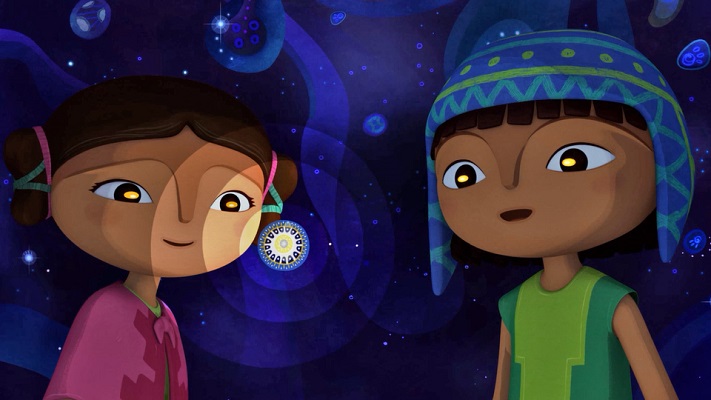
AV: How important is the music in your film?
JA: From the very beginning, I’ve imagined a music that will get the audience immersed into the pre-Columbian Andean world, using only the few elements available in that ancient time: winds, percussion and pentatonic scales, keeping it very natural, atmospheric and minimalistic. And then, with the arrival of the Conquistadors in the film, the music would change completely its style to become a European Renaissance music with all those new powerful instruments that came from the Old World (guitars, violins, cellos, brass, etc.) It was for me like a musical metaphor of the Conquest, and the score would have to be a dialogue between those two different styles of music, representing this clash of the cultures.
AV: Pierre Hamon also worked on the sound design, like the sound of certain animals. Can you tell me about that aspect?
JA: Actually, we’ve used for the sound design some samples of sounds produced by Pierre. For example, to create ambient sound we’ve mixed real ambient sounds with the sounds of some very strange flutes called whistling-vessels. They sound like birds or insects but not very realistic; that gives a special atmosphere to the film. Also, the sound of condor’s feathers was recorded from Pierre’s performance.
AV: Your collaboration with Netflix will allow a huge audience to get to know Pachamama.
JA: I am thrilled that Netflix acquired the rights of Pachamama to release it worldwide (except those that were part of the coproduction: France, Luxembourg, and Canada). I’m very excited because in a couple of days, they will launch it simultaneously in over 180 countries, dubbed to 19 languages! It’s amazing for me to have my film available to a huge audience like that; the message it carries will reach children of all the globe.

AV: Are you already working on another project? Can you tell us a little about it?
JA: Yes, I am working on the conception of another animated feature film. It’s still too early to give details, but I can tell you that it’s in the line of Pachamama but happening on the Amazonas. I am also working on the conception of a very funny animated series and also writing ideas for a live-action science fiction feature film.
Watch the Pachamama film trailer here
With very special thanks to Juan Antin, Fumi Kitahara and Olivier Mouroux.






